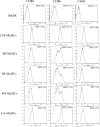Human monocyte-derived dendritic cells exposed to microorganisms involved in hypersensitivity pneumonitis induce a Th1-polarized immune response
- PMID: 23720369
- PMCID: PMC3754498
- DOI: 10.1128/CVI.00043-13
Human monocyte-derived dendritic cells exposed to microorganisms involved in hypersensitivity pneumonitis induce a Th1-polarized immune response
Abstract
Hypersensitivity pneumonitis (HP) is an immunoallergic disease characterized by a prominent interstitial infiltrate composed predominantly of lymphocytes secreting inflammatory cytokines. Dendritic cells (DCs) are known to play a pivotal role in the lymphocytic response. However, their cross talk with microorganisms that cause HP has yet to be elucidated. This study aimed to investigate the initial interactions between human monocyte-derived DCs (MoDCs) and four microorganisms that are different in nature (Saccharopolyspora rectivirgula [actinomycetes], Mycobacterium immunogenum [mycobacteria], and Wallemia sebi and Eurotium amstelodami [filamentous fungi]) and are involved in HP. Our objectives were to determine the cross talk between MoDCs and HP-causative agents and to determine whether the resulting immune response varied according to the microbial extract tested. The phenotypic activation of MoDCs was measured by the increased expression of costimulatory molecules and levels of cytokines in supernatants. The functional activation of MoDCs was measured by the ability of MoDCs to induce lymphocytic proliferation and differentiation in a mixed lymphocytic reaction (MLR). E. amstelodami-exposed (EA) MoDCs expressed higher percentages of costimulatory molecules than did W. sebi-exposed (WS), S. rectivirgula-exposed (SR), or M. immunogenum-exposed (MI) MoDCs (P < 0.05, Wilcoxon signed-rank test). EA-MoDCs, WS-MoDCs, SR-MoDCs, and MI-MoDCs induced CD4(+) T cell proliferation and a Th1-polarized immune response. The present study provides evidence that, although differences were initially observed between MoDCs exposed to filamentous fungi and MoDCs exposed to bacteria, a Th1 response was ultimately promoted by DCs regardless of the microbial extract tested.
Figures





Similar articles
-
Protein kinase D1 in myeloid lineage cells contributes to the accumulation of CXCR3+CCR6+ nonconventional Th1 cells in the lungs and potentiates hypersensitivity pneumonitis caused by S. rectivirgula.Front Immunol. 2024 Oct 11;15:1403155. doi: 10.3389/fimmu.2024.1403155. eCollection 2024. Front Immunol. 2024. PMID: 39464896 Free PMC article.
-
IL-4 blocks TH1-polarizing/inflammatory cytokine gene expression during monocyte-derived dendritic cell differentiation through histone hypoacetylation.J Allergy Clin Immunol. 2013 Dec;132(6):1409-19. doi: 10.1016/j.jaci.2013.08.039. Epub 2013 Oct 17. J Allergy Clin Immunol. 2013. PMID: 24139608
-
Hypersensitivity pneumonitis onset and severity is regulated by CD103 dendritic cell expression.PLoS One. 2017 Jun 19;12(6):e0179678. doi: 10.1371/journal.pone.0179678. eCollection 2017. PLoS One. 2017. PMID: 28628641 Free PMC article.
-
Hypersensitivity pneumonitis caused by fungi.Proc Am Thorac Soc. 2010 May;7(3):229-36. doi: 10.1513/pats.200906-041AL. Proc Am Thorac Soc. 2010. PMID: 20463253 Review.
-
Differential role of MAPK signaling in human dendritic cell maturation and Th1/Th2 engagement.J Dermatol Sci. 2006 Apr;42(1):1-11. doi: 10.1016/j.jdermsci.2005.11.004. Epub 2005 Dec 13. J Dermatol Sci. 2006. PMID: 16352421 Review.
Cited by
-
Immune responses to airborne fungi and non-invasive airway diseases.Semin Immunopathol. 2015 Mar;37(2):83-96. doi: 10.1007/s00281-014-0471-3. Epub 2014 Dec 13. Semin Immunopathol. 2015. PMID: 25502371 Review.
-
Discovery of highly immunogenic spleen-resident FCGR3+CD103+ cDC1s differentiated by IL-33-primed ST2+ basophils.Cell Mol Immunol. 2023 Jul;20(7):820-834. doi: 10.1038/s41423-023-01035-8. Epub 2023 May 29. Cell Mol Immunol. 2023. PMID: 37246159 Free PMC article.
-
Effect of thermal spring water on human dendritic cell inflammatory response.J Inflamm Res. 2019 Jul 22;12:181-194. doi: 10.2147/JIR.S213594. eCollection 2019. J Inflamm Res. 2019. PMID: 31413617 Free PMC article.
-
Monitoring the initiation and kinetics of human dendritic cell-induced polarization of autologous naive CD4+ T cells.PLoS One. 2014 Aug 21;9(8):e103725. doi: 10.1371/journal.pone.0103725. eCollection 2014. PLoS One. 2014. PMID: 25144736 Free PMC article.
-
Exposure of Human CD4 T Cells to IL-12 Results in Enhanced TCR-Induced Cytokine Production, Altered TCR Signaling, and Increased Oxidative Metabolism.PLoS One. 2016 Jun 9;11(6):e0157175. doi: 10.1371/journal.pone.0157175. eCollection 2016. PLoS One. 2016. PMID: 27280403 Free PMC article.
References
-
- Girard M, Lacasse Y, Cormier Y. 2009. Hypersensitivity pneumonitis. Allergy 64:322–334 - PubMed
-
- Tillie-Leblond I, Grenouillet F, Reboux G, Roussel S, Chouraki B, Lorthois C, Dalphin JC, Wallaert B, Millon L. 2011. Hypersensitivity pneumonitis and metalworking fluids contaminated by mycobacteria. Eur. Respir. J. 37:640–647 - PubMed
-
- Denis M, Cormier Y, Fournier M, Tardif J, Laviolette M. 1991. Tumor necrosis factor plays an essential role in determining hypersensitivity pneumonitis in a mouse model. Am. J. Respir. Cell Mol. Biol. 5:477–483 - PubMed
Publication types
MeSH terms
Substances
LinkOut - more resources
Full Text Sources
Other Literature Sources
Medical
Research Materials
Miscellaneous

